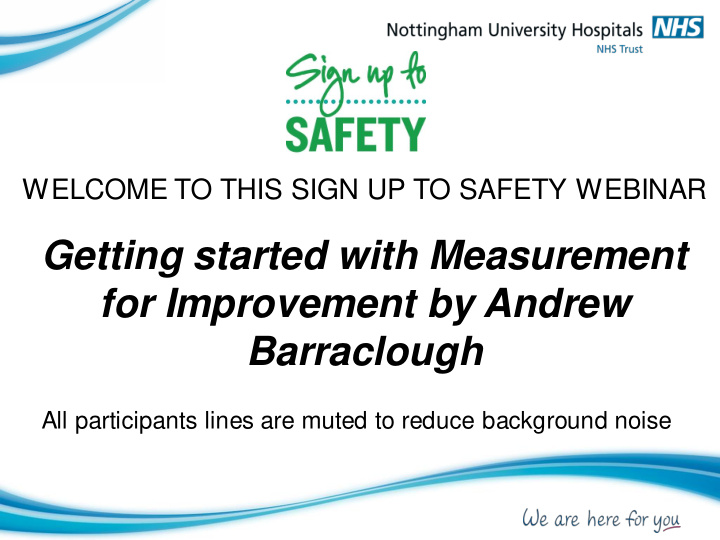



WELCOME TO THIS SIGN UP TO SAFETY WEBINAR Getting started with Measurement for Improvement by Andrew Barraclough All participants lines are muted to reduce background noise
“How we are supporting whole hospital transformation with measurement and data at Nottingham University Hospitals” Andrew Barraclough, Head of Analysis and Intelligence, Better for you, Nottingham University Hospitals
September measurement webinar series “How we are supporting whole hospital transformation with measurement and data at Nottingham University Hospitals” TODA Y Webinar 1: Getting started with Measurement for Improvement • Measurement for improvement – the what and why • Driver diagrams – refresh, examples and usage • Quality Measurement Journey – the what and why UPCOMING: 30 September, 1000-1100 Webinar 2: Learn to love your data! 3
Measurement & Improvement ‘Measurement is only a handmaiden to improvement, but improvement cannot act without it.’ Dr Don Berwick, A Primer on Leading the Improvement of Systems, BMJ, 1996, vol 312, p620 4
Better for you 5
Building Capacity And Capability Bfy Fundamental Course - Variants Bfy Fundamental Course Introduction to Measurement for Improvement An Introduction to Measurement for Improvement Patient Safety Programme – May 2014 Andrew Barraclough, Head of Analysis and Intelligence, Better for you Andrew Barraclough, Head of Analysis and Intelligence, Better for You 1 2 1 2 6
Building Capacity And Capability F2 Doctor Training Measurement Message of the Week 7
Measurement Skills Needed 8
Three Types of Measurement http://www.institute.nhs.uk/index.php?o ption=com_joomcart&main_page=doc ument_product_info&products_id=763 &cPath=94 9
Three Types of Measurement: Differences Aspect Improvement Accountability Research AIM Improvement of care Comparison, choice, New knowledge reassurance, spur for change METHOD Test Observability Tests are observable No test; merely evaluate Test blinded or controlled current performance tests Bias Accept consistent bias Measure and adjust to Design to eliminate bias reduce bias “Just enough” data, small “Just in case” data Sample Size Obtain 100% of available, sequential samples relevant data Flexibility of Hypothesis Hypothesis flexible, No hypothesis Fixed hypothesis changes as learning takes place Testing Strategy Sequential tests No tests One large test Determining if a Run charts or Shewhart No change focus Hypothesis, statistical tests control charts (t-test, F-test, chi square), Change is an p-values Improvement Research subjects’ Confidentiality of Data used only by those Data available for public involved with improvement consumption and review identities protected the Data 10 10
Patient Safety First on Measurement 11
12
Cause and effect driver diagram 1 AIM Good patient theatre experience 13
Cause and effect driver diagram 2 AIM PRIMARY DRIVERS Avoid Good patient unnecessary theatre delays experience Keep the patient informed Avoid unnecessary discomfort 14
Cause and effect driver diagram 3 AIM SECONDARY DRIVERS PRIMARY DRIVERS Avoid Minimise pre-op time Good patient unnecessary theatre Minimise starvation delays time experience Avoid cancellations Keep the patient Provide timely informed recovery Avoid Provide relevant unnecessary information discomfort Provide information in a timely fashion Control pain effectively Implement SSI bundle (inc. control body temp) Minimise complications in recovery 15
Cause and effect driver diagram 4 AIM SECONDARY DRIVERS PRIMARY DRIVERS Good patient Avoid P0 28 Minimise pre-op time unnecessary theatre Minimise starvation delays 29 P1 experience time 30 Avoid cancellations Keep the patient informed Provide timely 31 recovery Avoid Provide relevant unnecessary information discomfort Provide information in a timely fashion Control pain 32 effectively Implement SSI bundle 6 (inc. control body temp) Minimise 33 complications in recovery 16
Driver Diagrams – additional ideas 17
Driver Diagrams – further guides http://www.apiweb.org/QP_whats-your- http://www.institute.nhs.uk/qual theory_201507.pdf ity_and_service_improvement _tools/quality_and_service_im provement_tools/driver_diagra ms.html http://www.ihi.org/education/ihiopens chool/resources/Pages/Activities/Gol dmannDriver.aspx 18
19
Quality Measurement Journey A concept that can help us deliver on measurement for improvement AIM Concept Measure Operational Definition Data Collection Plan Data Collection Analysis ACTION Source: IHI then NHS Institute 2 0 20 20
QMJ Example 2 1 21
Documenting the QMJ 1 22 22
Documenting the QMJ 2 23 23
24
Measurement as a Social Process "Measurement is not a mathematical, natural science process. It's a social process. People do the measuring: it's not just about putting something into a machine that churns out a number.“ Dr Elaine Maxwell, the Health Foundation's Assistant Director for Patient Safety 25
Introducing Davis Balestracci 26
Use of Data as a Process 27
UPCOMING: 30 September, 1000-1100: Webinar 2: Learn to love your data! • Why Two Point Comparisons Are Evil • Born to Run-chart – measurement over time • Why I Hate Pie Charts • What Charts You Most Likely Should Be Using 28
Thank you andrew.barraclough@nuh.nhs.uk @ AndrewBarraclo1 UPCOMING: 30 September, 1000-1100: Webinar 2: Learn to love your data! 29
Recommend
More recommend